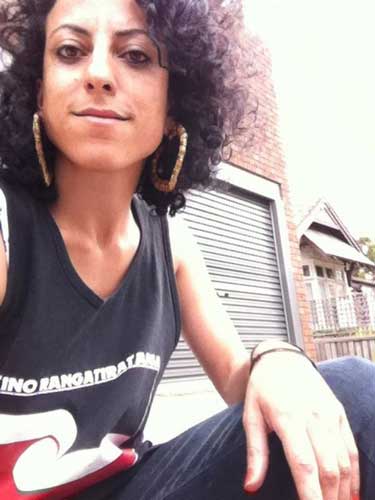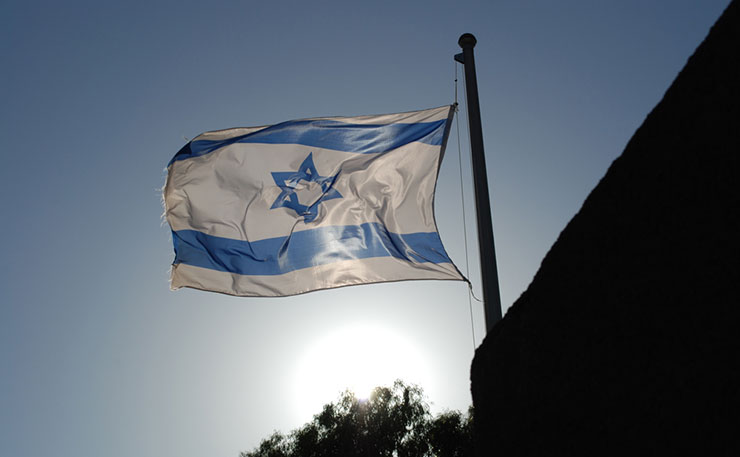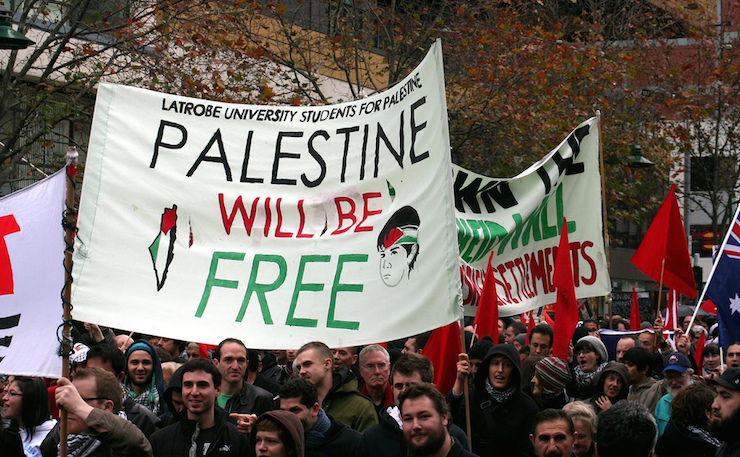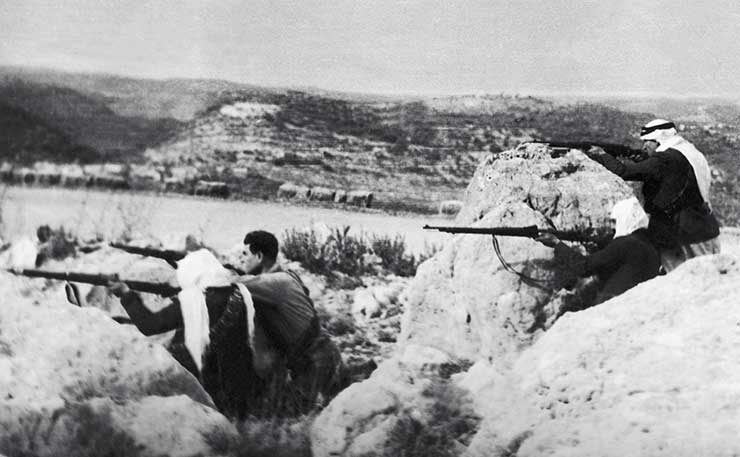Rihab Charida is a film-maker whose current documentary project, A Disturbed Earth, traces the history of the destruction of her father’s village in Palestine by Zionist militia in 1948.
In this interview, she speaks with Padraic Gibson from the Jumbunna Indigenous House of Learning about the themes of land, place, settler-colonialism, massacres and solidarity with Aboriginal struggles in Australia explored through her work.
A crowd-funding campaign to allow for the production of the documentary is currently running. More information is available here.
PADDY GIBSON: Could you give us an introduction to yourself and the film project?
RIHAB CHARIDA: I was born in Western Sydney to Palestinian – Syrian parents. I’ve travelled to the Middle East a number of times and spent a lot of time in the refugee camps with my father’s family. I visited my father’s village in 2004 in Palestine, which was completely destroyed in 1948 during the creation of Israel.
I dug through the rubble of the old homes that were destroyed at that time. It was then that I decided I wanted to learn what happened to cause the destruction of the village and the expulsion of the people.
These people, living now in refugee camps, are not allowed to return. I can visit, because I carry an Australian passport.
It often seems like there is plenty of coverage of Palestine. But I have been surprised to learn about how little information is available about what took place in 1948. I started to pull together information from very different sources. Out of that research, the idea for the film emerged.

I’ve been working with a small crew, mostly based in Sydney. We’re documenting a journey back to the village, which is also investigating what took place. We are speaking with elders, who were expelled from the village at the time, and looking through archival footage, including Israeli military footage, basically putting the fragments of the picture together.
Before 1948, the year that Israel was created, there were roughly 520 Palestinian villages in existence. Between late 1947 and early 1949 about 450 of these were razed to the ground and the people of those villages were expelled. That came under something called “Plan Dalet” or “Plan D”, undertaken by Zionist militia groups under the command of the Haganah.
“Plan D” dictated that villages would be invaded from three points, leaving only one point open.
My father’s village is in North Palestine, close to the border with Lebanon. It was attacked from three sides, giving them no choice but to flee through the North, over the border into Lebanon.
This took place all over historic Palestine. Many people ended up in Gaze for example, where 80 per cent of the population are refugees that come from parts of what some people call Israel.
My father’s village was invaded on the 29th October, 1948. There was a resistance effort from the men in the village, who gathered whatever arms they could, which were very few and obsolete.
They tried to defend the village as best they could and the invading militias suffered a lot of casualties because of the staunch resistance.
When they finally did get in, as a way to punish the village, they gathered as many men as they could, blindfolded them, put them up against the wall and gunned them down.
They forced their families to witness the massacre, as a way to scare them from ever coming back.
Those who survived walked by foot over the border into Lebanon and were forced to squat in tents in a village in South Lebanon until refugee camps – 12 of them, which are basically concrete ghettos – were created throughout Lebanon.
Most of the people from my village ended up in a camp in South Lebanon. If they drive for an hour to the border, they can see their village. But they can’t go there, they can’t touch it, they can’t ever visit.
As I’ve said, despite Palestine being in the news so frequently, there is still little known about what took place in 1948. I feel that cinema is a powerful medium and that this story needs to be told from the perspective of the people who experienced it.
PG: I’ve heard you speak previously about this film and the way that places in the film will become characters. Can you talk a bit about these places?
RC: Through this documentary, rather than have the story take place in a location, we want the location itself to speak. The refugee camps for example, you walk through these very narrow alleys, with broken pipes everywhere that splatter dirty water on your jeans.
The place is alive really, breathing, speaking of the destitution, the despair that overwhelms the camp. But there’s also graffiti on the wall that speaks about hope through struggle, about the dream of return.
Or take my father’s village. There’s a mountain very close to the village and in my research I’ve found that there are lots of poems, folkloric poems and songs written by people from the surrounding villages. The mountain is praised through this folkloric culture.
Currently it’s occupied by Israel, and that mountain has become one of Israel’s largest military bases, watching over the south of Lebanon.
They’ve actually ripped the heart of the mountain out to create infrastructure for fighter jets. These fighter jets fly out from the mountain to carry out attacks, like when they bombed and destroyed many parts of Lebanon in 2006.
This gives you an idea of the difference between the colonial experience of living on a place, as opposed to the Indigenous experience of living with a place. In one instance, this mountain is sung to. It’s the object of love poems. In another sense, it’s a military base and a cradle of death.
This idea, this framework of how to love and connect to land and place from an Indigenous perspective, I was taught that by Aboriginal people here on this continent, through time shared in protest camps to defend Aboriginal land from fracking and mining.
I did not grow up in my homelands, in Palestine, but here on Aboriginal country and I will forever be indebted to Aboriginal people both for being able to share their land and this framework.
PG: I know that solidarity with Aboriginal struggles is a central part of your activism and perspective and will feature strongly in the documentary. Could you talk more about your place here, on this continent, and the role that will play in this film?
RC: Being Palestinian, being born and raised in a colonial context on this continent, both have informed my perspective. The first time I visited Palestine, I began to understand what it must feel like to be Aboriginal on this continent. I stood and watched the layers of colonialism that cover the land and place and felt the disjuncture of that experience with the historic experiences and relationships of Indigenous people.
I have spoken to a number of Aboriginal Elders from different countries across this continent and learnt how similar the struggles have been. Especially in the context of what happened in our village, the massacre that took place, the denial of the people of that village to pay their respects or conduct a dignified burial.
Being able to conduct proper ceremony over people’s deaths when they have been killed so brutally is extremely important in both cultures. Not being able to do that, creates a brokenness for those communities.

Many of my Elders went to their graves with hearts broken by that massacre. My grandfather, whose two nephews were killed in that massacre, went to his grave talking about them. They used to work the land with him. He witnessed their murder.
There are countless stories from Aboriginal communities that are so similar. I spent some time in the Leard forest recently, doing a news story. The Gomeroi mob there, they were prevented by the mining company from gaining access to their country, the forest, to perform ceremony.
They wanted to ease the experience of impending destruction, both for their ancestors and themselves, but they were denied this simple right, which had a huge effect on them.
It was in that moment that I realised this has to be a strong element of the documentary. The experience that I’m talking about is not particular to Palestine, it’s a universal experience and it’s certainly happened here.
The film will be launched here, so it only makes sense that it starts with, not just an acknowledgement, which is of course absolutely important, but a sharing of stories amongst Indigenous people that can build power.
My father, who witnessed the massacre, he was 9-years-old at the time. He will be speaking to Elders here and they will be sharing poems and experiences.
PG: I know that you have a long history of activism here in Sydney. We have worked together on anti-war and anti-racist campaigns. In those sorts of contexts, where there are other minority groups, such as Arab and Muslim people, experiencing racism, what do you think is the importance of addressing the questions also of Indigenous dispossession and settler-colonialism?
RC: I believe that for anybody that’s here, active on any issue, the saying “there can never be justice on stolen land” is absolutely true. All struggles must start with and incorporate full acknowledgement of the injustices past and present, because they continue unabated.
The Australian government has very successfully cultivated an image as a friendly country with many opportunities. But that’s a very different story for the people of this continent.
Migrants come here, many of them have been refugees, friends I’ve met from Syria and other places and they have now seen for themselves the true reality of what has happened here and what is happening here, because it’s still happening.

Anybody who just opens their eyes and is willing to see can see those deep injustices everywhere, from the incredible rates of incarceration of Indigenous people and deaths in custody, the ongoing destruction of Indigenous lands, the list goes on.
I’ve seen that process in people coming to learn about this and incorporating this into our activism and it’s very powerful. It’s also basic human decency. We are in the home of Aboriginal communities, it makes sense to respect that story and form solidarity with the people of this land.
PG: Your campaign, a fundraising campaign to help you produce this documentary, is going to be finishing on the date of the Nakba, May 15, when Palestinian people remember and continue to protest against the initial expulsions that took place to form ‘Israel’. The previous day is celebrated by Israeli’s as their ‘Independence Day’. There’s a real parallel with Australia, where ‘Australia Day’ is promoted and celebrated when, for Indigenous people, this is their Nakba, the catastrophe when the invasion and the destruction of their societies began. This is officially encouraged as a day of celebration, but has always been contested by Aboriginal people and their supporters here also. It’s never easy to stand against the barrage of official propaganda and bring that truth to light, it is an ongoing struggle. Can you talk about how you are going about trying to get the resources together to make this film and tell the truth of what has happened?
RC: We’ve been researching for four and a half years and it’s been a real struggle to get all the pieces together because of the restrictions on information by the Israeli authorities. I’m not even sure if I will be ‘allowed’ to enter, so we’ve been strategising about this, thinking of ways to get around any obstacles they may put in our way.
We are relying on crowd-funding though. There is a campaign that we have put up, not just for financial support, but to give people a description of the film project, what we are trying to achieve, the basic story line, etc.
There’s contact information if people want to know more, or get involved in some way. It would be great if people could visit the page and give us some support, even just by sharing through your networks.
Donate To New Matilda
New Matilda is a small, independent media outlet. We survive through reader contributions, and never losing a lawsuit. If you got something from this article, giving something back helps us to continue speaking truth to power. Every little bit counts.




